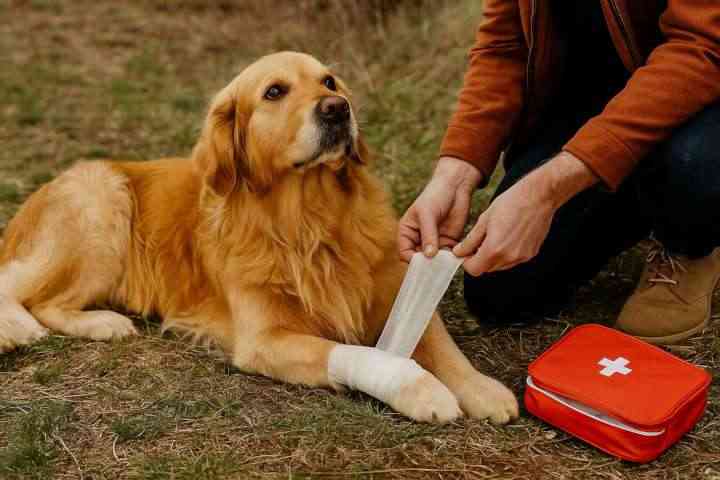Whether it’s a bee sting, a cut paw, or something more serious like choking or heatstroke, knowing what to do in a canine emergency can save your dog’s life. Every second counts—and being prepared with basic dog first aid knowledge can make all the difference.
This vet-approved guide covers the essential first aid steps for dogs, from how to handle common emergencies to when to seek immediate veterinary help.
First Aid Essentials Every Dog Owner Should Have
Create a dog-specific first aid kit with:
- Gauze rolls and non-stick bandages
- Antiseptic wipes or spray (chlorhexidine or iodine-based)
- Tweezers and blunt-tip scissors
- Digital thermometer (rectal)
- Hydrogen peroxide 3% (for vomiting—only if advised by a vet)
- Styptic powder (to stop bleeding)
- Saline solution (for eye or wound flushing)
- Muzzle or soft cloth (injured dogs may bite)
- Emergency contact list (vet, 24/7 ER, poison control)
- Gloves, towel, and leash
Keep one kit at home and another in your car or dog travel bag.
What to Do in Common Dog Emergencies
- Bleeding or Wounds
- Apply direct pressure with a clean cloth or gauze for 5–10 minutes
- If bleeding doesn’t stop, use a bandage and head to the vet
- Clean minor wounds with saline or diluted antiseptic
- Don’t use hydrogen peroxide on deep wounds—it slows healing
- Choking
- Signs: Pawing at mouth, gagging, distress, blue gums
- Open the mouth and check for visible objects—remove gently with tweezers if safe
- If not breathing, perform Heimlich for dogs:
- Small dogs: Lay on back, apply sharp thrusts to abdomen
- Large dogs: Stand behind, place hands below ribs, push inward/upward
- Get to the vet immediately, even if object is dislodged
- Heatstroke
- Signs: Excessive panting, drooling, vomiting, red gums, collapse
- Move to a cool area, offer small sips of water
- Wet the dog with cool (not cold) water, especially belly and paws
- Use a fan or AC
- Go to the vet ASAP—heatstroke can cause organ failure
- Poisoning
- Common toxins: chocolate, grapes, onions, xylitol, antifreeze, meds
- Signs: Vomiting, drooling, tremors, seizures, lethargy
- Call your vet or animal poison control immediately
- USA: ASPCA (888) 426-4435
- UK: Animal PoisonLine 01202 509000
- Do not induce vomiting unless instructed
- Bring the packaging or label of the toxic substance to the vet
- Seizures
- Stay calm and don’t restrain your dog
- Move objects away to prevent injury
- Time the seizure duration
- After the seizure, keep your dog quiet and warm
- If seizure lasts more than 5 minutes or repeats, seek emergency care
- Broken Bone or Lameness
- Don’t try to reset the bone
- Muzzle your dog to prevent biting (even friendly dogs may bite in pain)
- Gently stabilize with a towel, splint, or flat surface
- Transport to vet with minimal movement
- Insect Bites or Stings
- Look for swelling, redness, or hives
- Remove visible stinger with tweezers
- Apply cold compress
- For mild reactions: oral antihistamines (like Benadryl) may help—ask your vet for correct dosage
- Watch for signs of anaphylaxis: vomiting, collapse, difficulty breathing → go to ER
- Eye Injury or Irritation
- Flush with saline solution
- Prevent rubbing or scratching (use an Elizabethan collar if needed)
- Seek vet care—eye injuries can worsen quickly
- Burns (Chemical or Heat)
- Flush chemical burns with cold water for 10+ minutes
- For thermal burns, apply cool, wet compresses
- Do not apply ointments or creams
- Cover loosely with a clean cloth and go to the vet
When to Go Straight to the Vet
Always seek emergency veterinary care if your dog:
- Can’t breathe
- Is unconscious or unresponsive
- Is bleeding heavily
- Has a broken bone
- Shows signs of poisoning
- Has a seizure lasting more than 5 minutes
- Is hit by a car (even if they seem fine)
- Ingests a foreign object (toys, bones, socks)
Stay Calm, Stay Focused
In an emergency, your calm response can save your dog’s life. Act quickly, use your first aid knowledge, and get professional help as soon as possible.
Conclusion
Every dog owner should know the basics of canine first aid. Being prepared and acting quickly can prevent serious complications—or even save your dog’s life.
Want a printable First Aid Checklist or Emergency Contact Sheet? Visit our Dog Safety Center to download free resources for home and travel.

